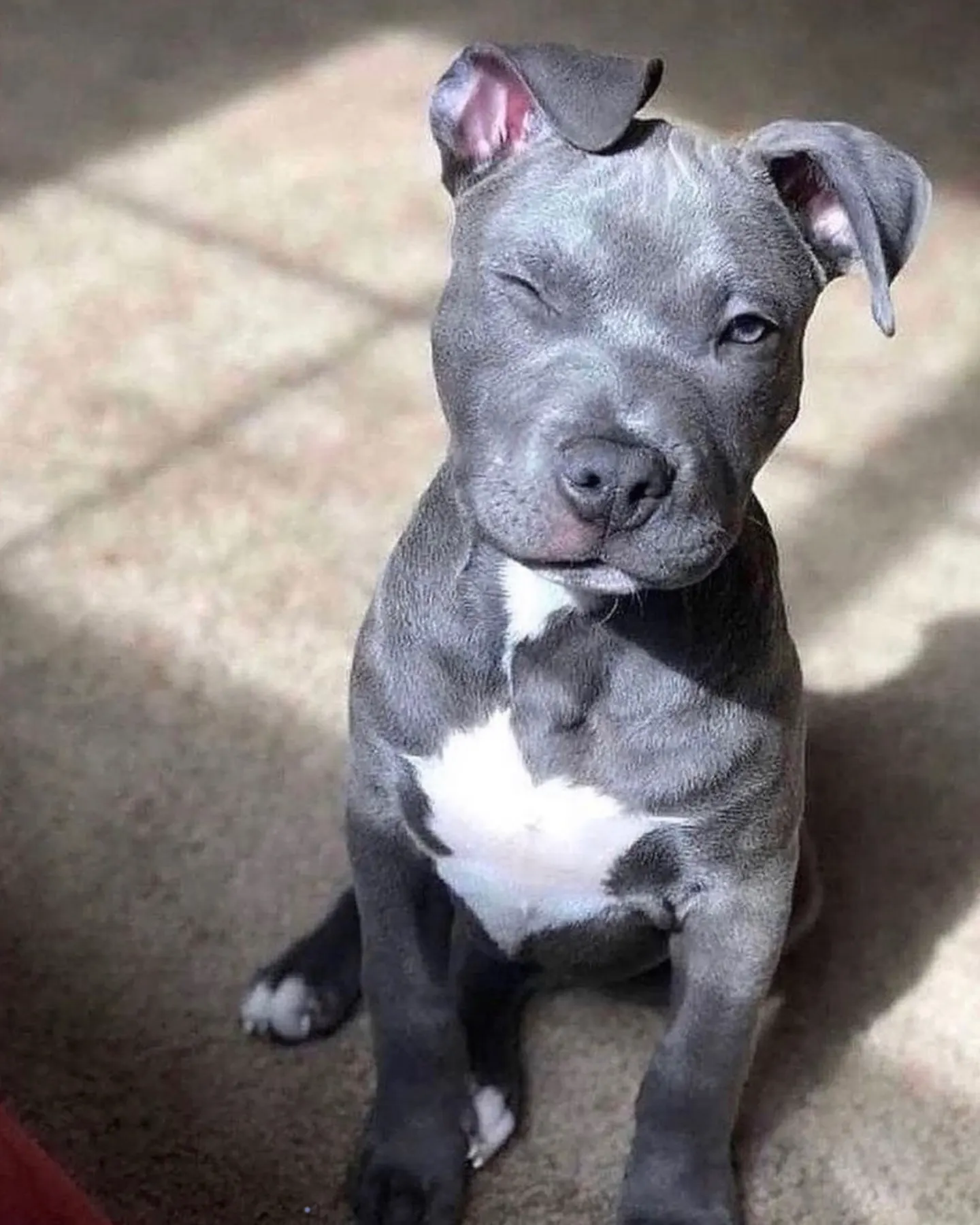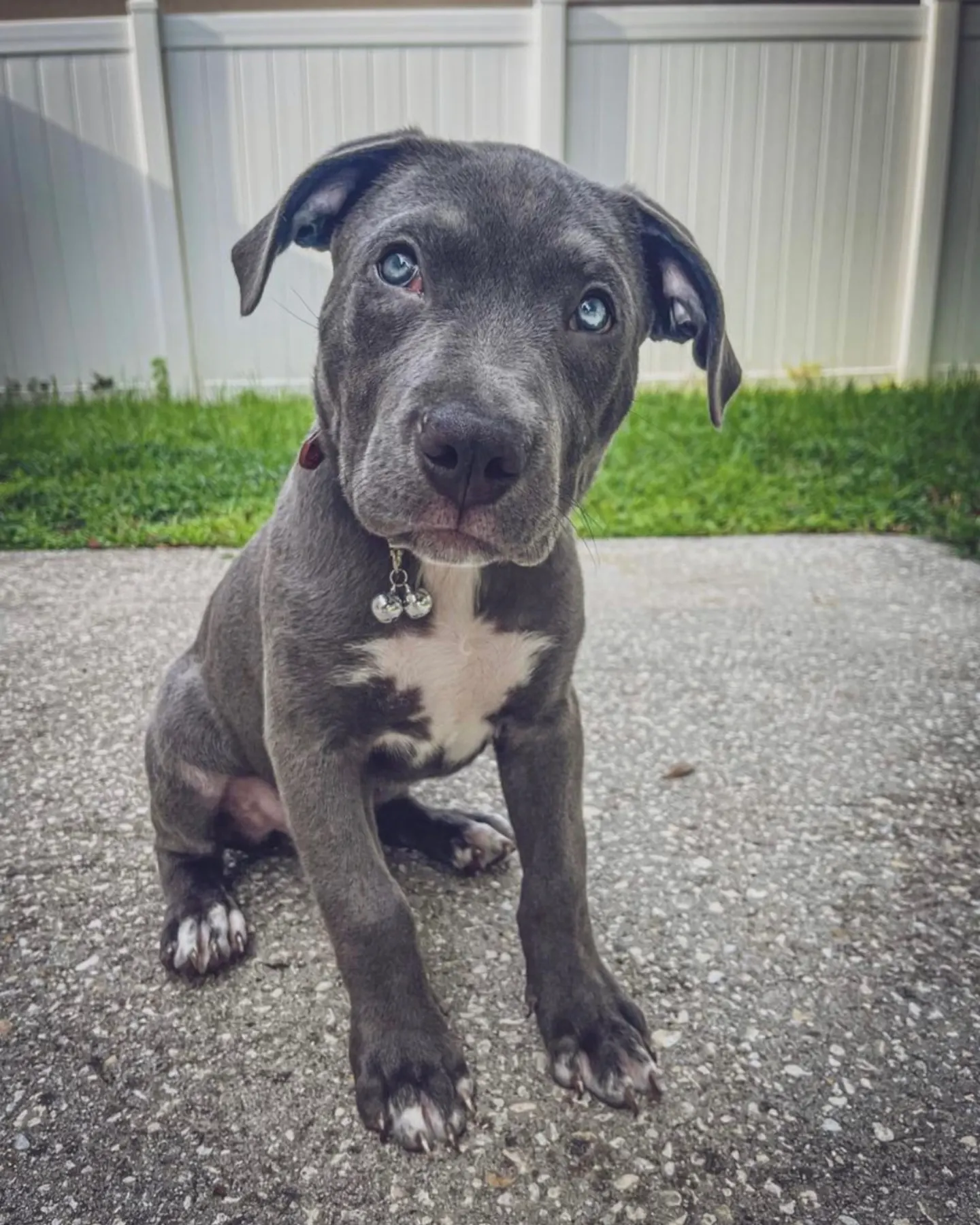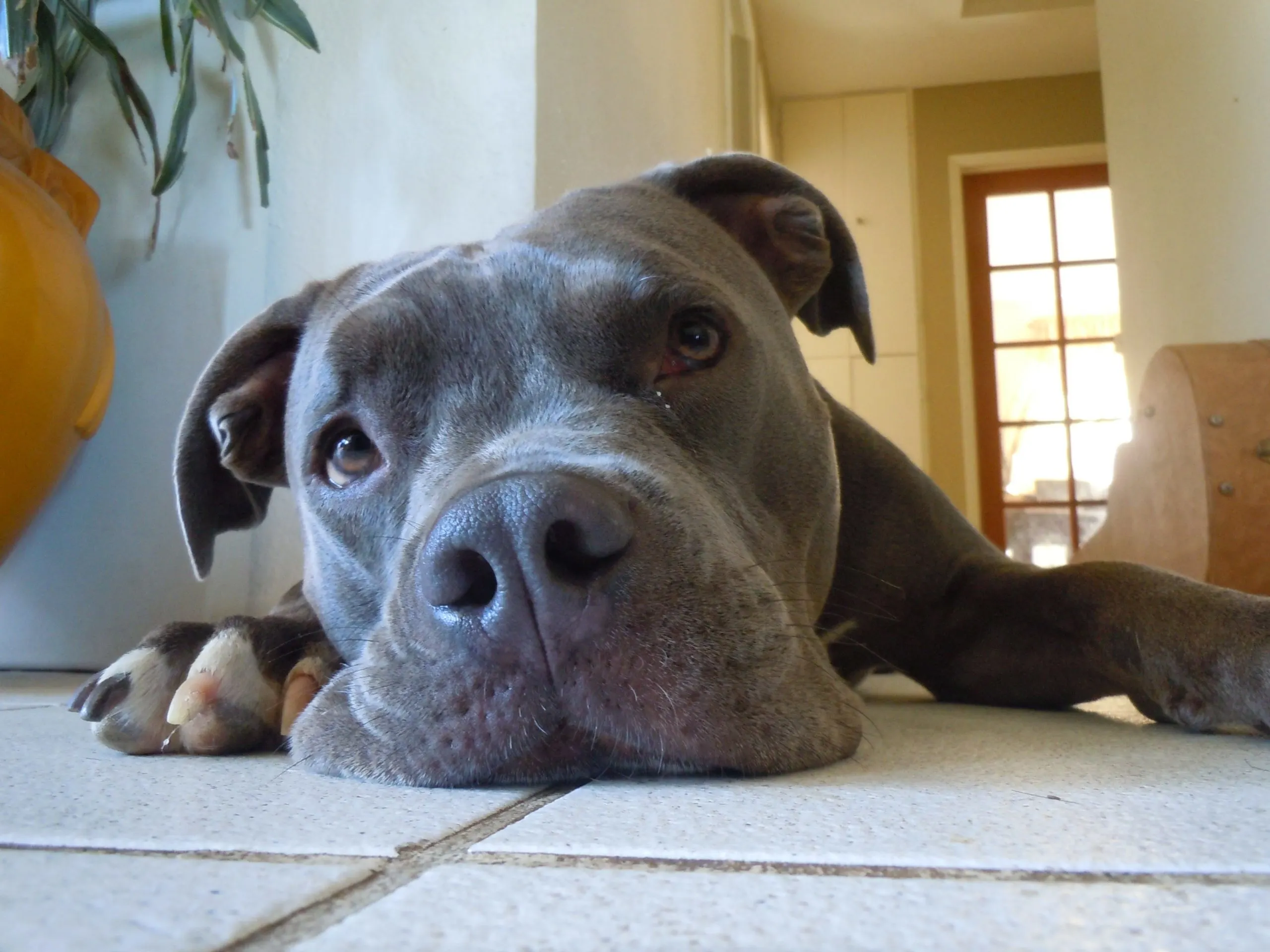Most people have a very strong opinion about Pitbulls. Some love them, some hate them. However, we believe that the ones who hate them, either never got to know a Pitbull that well, or only came in contact with Pitbulls that were trained by the wrong people. But, while all of us know about the Pitbull breed, many dog lovers haven’t even heard about Blue Nose Pitbull.
The Blue Nose Pitbull isn’t exactly blue, but it definitely is a rare and popular color variation of this classic breed. They do, however, come with certain problems that all people interested in the Blue Pit should be made aware of. Some of them are harmless, while others could make the life of your puppy much harder than it needs to be.
In this article, we are not only going to explain why all Pitbulls have a wrongfully bad reputation, but we will also explain what the Blue Nose Pitbull is, and what makes him stand out. So if you are one of those people who do hold certain judgments over Pitbull dogs, get ready to change your opinion. But even if you are not, you are still going to learn something interesting about one of the rarest Pitbull color variations.
What are Blue Nose Pitbulls? What do they look like?
The Blue Nose Pitbull is a regular Pitbull in a rare color variation and not a separate breed. The only difference between the Blue Nose Pitbull and other Pitbulls is its color. They have the same temperament, training disposition, and exercise needs. But they can have some health issues that regular Pitbull color variations aren’t that prone to.
They are pretty big dogs, standing between 17 and 21 inches tall and weighing between 30 and 60 pounds. They are stocky and athletic, and their bodies are very muscular as a whole. This is matched by a broad face, a short muzzle, and ears that point up. Many people choose to cut off, or “dock,” the ears of their dogs. However, in many States, ear docking is banned.
Blue nose varieties usually have a solid “blue” color, with blue eyes and a nose that is the same color as their coat. They can also have a brindle stripe or other white markings, though. But don’t expect them to have a Strumf blue color. In the canine world, blue is referred to as a diluted black-grey color with a blueish undertone.
Their short, shiny coats tend to shed only twice a year, in the spring and fall. Their coats usually only need to be brushed once a week or once a month, depending on how they live, to stay healthy and shiny. We will touch more on their grooming needs later on in the article.
As we already explained, these dogs can also have different white markings on their coat. If it’s a brindle marking, they look like white marks around the eyes and down to the nose. Markings can also go from the nose down the neck and chest. It’s also not unusual for these pups to have white marks on their feet that look like little socks.

Source: Instagram (@bullterrierpro)
Why are Blue Nose Pitbulls “blue”?
As we already explained, the skin, eyes, nose, and toenails of a Blue Nose Pitbull have a rare blue-gray color. This is what makes them stand out. But you might be wondering: “What gives them that unique color?” The answer is – a genetic mutation! Yup, there are even other rare color options available, like Red Nose Pitbulls, which have amber-colored skin, eyes, noses, and toenails. And no, these blue and red dogs don’t look like little aliens or demons who follow you around.
If you paid attention in biology class, you probably know that genes can be dominant and recessive. When two parent dogs with recessive coat-color genes have offspring, the offspring will have a striking blue or red color. This doesn’t happen very often in nature, because in most cases the puppy will inherit at least one dominant gene. Pitbulls with these recessive genes are rare, and it’s even rarer for two to cross the same dog’s path.
Because these genes are recessive, less melanin is made. Melanin is the main thing in the skin that makes skin color what it is. It is the reason why people get tan in the sun, or naturally have a darker skin tone. Because Blue Nose Pitbulls produce less melanin, their coat will have the signature diluted light gray color.
Beware of backyard breeders
Remember how I said that Blue Nose Pitbulls are rare because the recessive gene is rare? Well, this makes it hard for “backyard breeders” who want to make money off of the rare color trend. In order to sell more and more of them, even though they are super rare to find in nature, irresponsible breeders keep inbreeding these dogs.
Sure, inbreeding makes money for the breeders in the short term, because it is hard to tell if a dog is inbred at first, especially if he is still a puppy. But inbreeding can lead to health problems like immune disorders, hip dysplasia, cancer, allergies, heart disease, and cataracts. All of these diseases can affect how long your dog lives and what the quality of his life will be like.
Blue Nose Pitbulls are already more prone to have problems with their immune and nervous systems because they don’t have enough melanin. This can cause problems like deafness, poor vision, skin spots, and alopecia. Many breeders who only care about making dogs with blue coats lose sight of what’s more important: an even temper. Too many Blue Nose Pitbulls are born with aggressive or stubborn traits because of this.
Blue Nose Pitbull Temperaments
Even though Pitbulls have been used for fighting and protection in the past, they are great family dogs and make great pets. They are very brave and will give their lives to protect their family. These dogs are smart and want to please their owners, which makes them easy to train. But they need to know who is in charge, so they do better with experienced dog owners.
Pitbulls need a lot of love and attention, behind their intimidating looks, they are huge babies that love to cuddle. They are not the type of dogs that can be left alone for hours at a time. They are prone to separation anxiety, and if you live a busy life and you are often away from home, you can either get a dog nanny or choose a different pet.
When left alone with nothing to do, Pitbulls can become frustrated and act destructively. They could dig and eat up your furniture. You can only imagine how much damage their strong bodies can do. Make sure you buy toys that can stand up to their strong jaws and are of good quality.
They get close to the people they live with and will protect them, especially children. They are usually very aware of and sensitive to the needs of children, and many people even call them nanny dogs. However, you should never leave them alone with young children without supervision.
Even though they are big, they still want to be held. If you let them, they will love to snuggle with you on the couch. Blue Pits love their people, but they can be a bit possessive. So when other animals come near you, they could start to act up a bit. This can be lessened if they are socialized from a young age.
Are Pitbulls aggressive?
Pitbulls are a bit like Taylor Swift. How you may ask? Well, both of them have a bad reputation for things that should be left behind in the past. A long, long time ago, Pitbulls were used in dog fighting shows. They were trained to be as aggressive as possible, however, that does not mean that this trait is natural to their temperament. And the same thing applies to the Blue nose Pitbull.
The sport was slowly made illegal, but Pitbulls were still often chosen by people who wanted to scare others. They also became a sign of gang culture. In the 1890s, when American breeders tried to get their dogs registered with the American Kennel Club, they were turned down because the dogs were linked to fighting and aggressive behavior.
Because of this, the breeders made the United Kennel Club, a rival club, to register the dogs. Dogfighting was also regulated by the club and highly forbidden. By the 1930s, there was a lot of pressure to register the breed, but the American Kennel Club still wasn’t down to do it. They didn’t want to support dog fighting, so they registered it with the name American Staffordshire terrier instead of the Pitbull.
All through the 20th century and into the early 21st century, these dogs were still used in fights. In the 1990s, it is thought that about 1,500 Pitbulls died each year in the US because of dog fighting. In the early 2000s, it is thought that more than 40,000 people were involved in the sport. By now, this trend has died down a bit, however, it would be naive to think Pit fighting it’s completely gone.
Can a Pitbull be dangerous?
In theory, yes. A CDC report from 2000 says that Pitbulls were responsible for about one-third of all fatal dog bites in the 1980s. This was more than any other breed of dog. Their bites do seem to hurt more than bites from other dog breeds. This is because Pitbulls are stubborn and won’t let go of a bite, even when they’re in pain. Their jaws are naturally strong because they have wide faces and strong jaw muscles.
However, a dog that was given the proper training wouldn’t simply go up to someone and bite them. Studies have shown that Pitbulls are not naturally aggressive dogs and don’t usually have problems with strangers. However, because they are often chosen and trained to be violent, they are more likely to be in situations where they are encouraged or even required to bite.
So what does this mean for the breed? Pitbulls can be dangerous weapons because they are strong and determined, but they are not naturally aggressive. If you want to adopt a Pitbull, but you are scared that he will be a threat to your friends and family, we are here to tell you that you have nothing to worry about. Pitbulls have a sweet nature, but you just have to give them the training and socialization that they need.
Health issues of a Blue Nose Pitbull
Since the blue gene is recessive, breeders tend to breed Blue Nose Pitbull dogs with each other. Pulling from a small gene pool leads to less variety, genetic problems, and health problems that keep coming back. You should be aware that hip dysplasia, skin allergies, and hypothyroidism are all common health problems with this breed. That’s why buying from a reputable breeder who does not inbreed his dogs is so important.
Hip dysplasia is a common problem for larger dogs, including Pitbulls. This is a joint deformity that can make the joint hurt more and more over time. The best way to stop this from happening is to not overwork your dog when he or she is a puppy. This can cause different growth rates in his bones and make the problem worse.
Both skin allergies and food allergies are common problems for Pitbulls. Rice, wheat, and corn allergies are especially common. You should try to stay away from these foods when choosing the right kibble for your pup. Hypothyroidism is another problem that Pitbulls often have. This causes an imbalance in your dog’s hormones, which can make him put on weight and feel tired.
The same recessive genes that create their rare color can also cause them to lose their hair early and have a weaker immune system. This is making it harder for them to fight off infections than other dogs. Their weak immune systems make them more likely to get heart disease, which could significantly shorten their lives.

Source: Instagram (@kawa_m_official)
Caring for a Blue Nose Pitbull
Caring for a Pitbull is actually pretty easy to do. These dogs have coats that are easy to groom, and they are intelligent and simple to train. But they do need a high amount of exercise, and top-quality dog food that is rich in proteins.
Their short and shiny coat is pretty easy to maintain. The Blue Nose Pitbull sheds twice a year and you only need to brush and bathe him occasionally. Brushing your dog’s teeth at least a couple of times a week and giving him dental chews can help keep his teeth healthy. Remember that dog dental problems like periodontal disease can lower the quality of your pup’s life. Also, make sure you trim your dog’s nails and clean his ears when there is a need to.
Pit bulls are very active dogs that love to play and go on adventures. Adult Pitbulls need a lot of exercise—about one to two hours a day, preferably split up into at least two sessions. Most of the time, the best way to do this is to include your dog in your own physical activities, like running or hiking. However, keep in mind that in many places, laws say that Pitbulls must always be on a leash in public to keep them from attacking other dogs.
When you train your Blue Nose Pitbull puppy, you’ll need to be kind and gentle and have a lot of patience. The best way to train this smart but stubborn breed is to be consistent, have short training sessions, and make it fun. They thrive on positive reinforcement training, and also do amazing with professional dog training classes.
What to know before buying a Blue Nose Pitbull puppy
Even though Blue Nose Pitbulls can be some of the most sensitive, kind, and gentle dogs on the market today, people’s mistakes have given them a bad name and made them controversial. You can do a lot of research on breeders and take your chances with a Blue Nose Pitbull, or you can choose an American Staffordshire Terrier, which is the “show dog” Pitbull and has less variation in temperament and health.
You can expect to pay more for a blue-nosed Pitbull than for other Pitbulls because of their rare coloring. Depending on where you live and how much demand there is, you can expect to pay between $1,000 and $3,000. Breeders raise the price of Blue Nose Pitbulls because they think that people will pay the unfair price because they so badly want a rare dog. Some Blue Nose Pitbulls cost even way more than $3,000.
But don’t fall for this scam, it would be unreasonable to pay more than 3 grand for a dog of this breed. You should go to a reputable breeder who breeds his dogs ethically and does not use inbreeding. In addition to that, always make sure that he can provide documents about health tests. That way you will know that you are getting a healthy dog.
Conclusion
As you can tell by this article, the Blue Pit isn’t nearly as intimidating as others make him out to be. However, this color variation in particular does come with certain problems. And most of them are due to irresponsible breeding. So if you do decide to get one of these babies, the most important thing you can do is to buy from a known, reputable breeder.
But other than that, Blue Nose Pitbull puppies would make great dogs for many different families. They love to cuddle and get along well with children. They will gladly keep you company on any adventures that you may go on.
The Blue Nose Pit Bull enjoys an active lifestyle, and they aren’t the best fit for apartment dwellers that spend most of their time on the couch. These blue puppies need their daily exercise, and one short walk a day won’t cut it. Besides their bodies, you also need to exercise their mind. They love to solve puzzles and play games with their owners.
It’s really sad to see that this innocent dog breed still has such a bad reputation. When in the right hands, they make amazing and lovable pets. Don’t let their history as fighting dogs scare you off. The only purpose their strong and wide jaws have these days is to give their family members as many smooches as possible.

